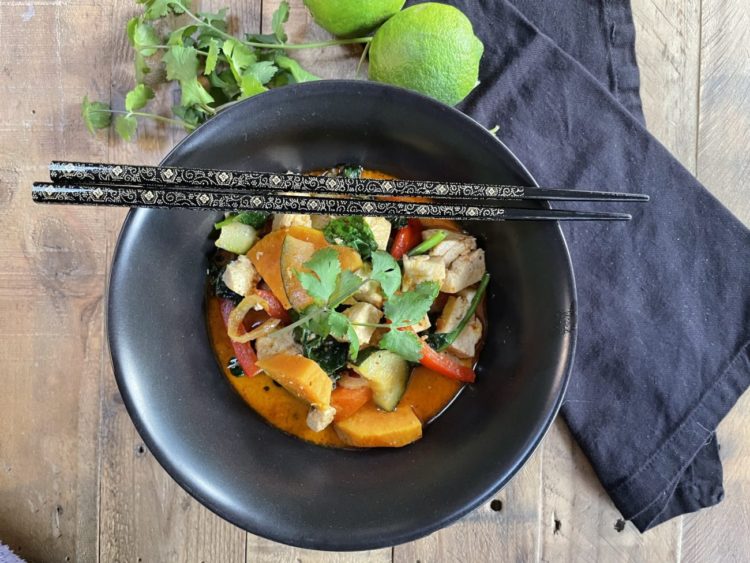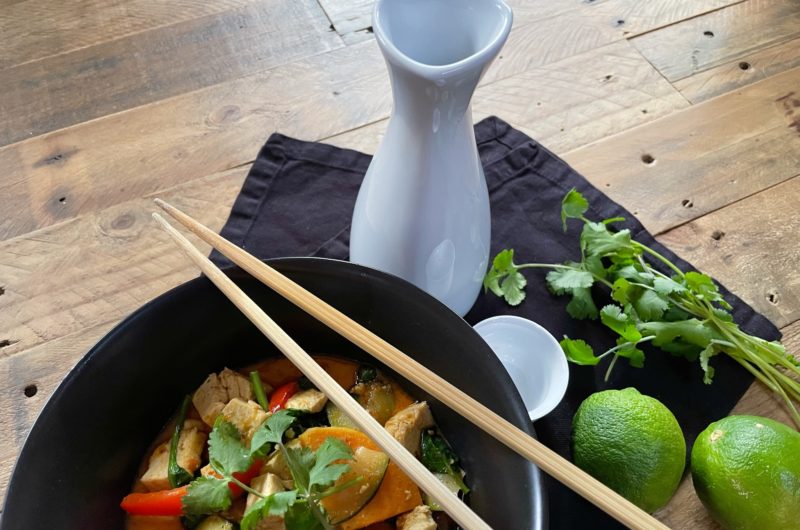Enjoy this Thai curry stew packed with flavor and spice using a few simple ingredients. Easy-to-make and quick to whip up. This is prefect for a busy work or school night.
This recipe is excellent for using up vegetables going bush in the refrigerator. Do not know where to use extra zucchini or mushrooms slices hitting its expiration date? Thai curry stew is the answer! We usually plan our curry meals at the end of the week when we know we will have extra vegetables to use up. Or if your freezer needs a purge, this dish rolls out the welcome mat for those vegetables too.
Why is this important? I cannot count how many times I read or hear omnivores complain about the spoilage that occurs when buying vegetables. If you have been living under a rock – news flash – tossed vegetables is contributing to our methane gas build up which negatively impacts our environment. There are ways to curb the food waste while still following a plant-based diet. One of these tips is to use recipes that help use up vegetable or fruits such as this curry stew, stir fry or Moroccan tagines. If you cannot pull that off, then freeze your vegetables to use in future recipes. Or if you are crafty, compost your scraps and/or utilize the city composting system.
Tofu & Vegetable Thai Curry Recipe Tips
- Curry Paste: There are a variety of Thai curry pastes available at the grocery stores. The most popular pastes are red and green curry. However, there are other Thai curries such as Panang or yellow curry. The other varieties will be available at your local International or Asian market. Curry paste goes a long way. It can be spicy. If you prefer less spice, start with one tablespoon. This recipe calls for two tablespoons because we prefer the spicy kick.
- Vegetable Oil: Any oil with a neutral flavor will work in this dish such as vegetable blend, canola or sunflower oil.
- Vegetable Choices: You can use a variety of vegetables. Some of the common vegetables include carrots, baby bok choy, green cabbage, zucchini, pumpkin, squash, broccoli, mushrooms, spinach, red pepper and sweet potatoes. However, you can use any vegetable combination you prefer. If you prefer a chunky stew, then use a total of 3-4 cups of vegetables. Or if you prefer more broth than vegetables, then scale it back.
- Tofu: We prefer the high protein firm tofu in this dish such as Trade Joes. You can pan-fry the cubed tofu using a tablespoon of milk flavored vegetable oil or use the tofu straight from the package. The pan-fried tofu holds its shape more and delivers a more crispy bite versus using it fresh.
- Coconut Milk: There are a few options when it comes to coconut milk. Typical offerings include regular coconut milk and light coconut milk which has less fat content. Then there is also coconut cream which contains mostly the solid saturated fat portion of coconut milk. We recommend the low-fat coconut milk. It will still impart the rich mouthfeel without the added calories. However, if you are transitioning away from animal meat, one of the side effects is your body seeking out fattier and/or carbohydrate-centric meals. This is a temporary side effect and typically fades away after a week or two when you retrain your body to eliminate animal meat. Keep in mind, your body has been wired to eat animal meat for years. Taking it away does cause an adjustment period.
- Cooking Vegetables: Cook the hardy vegetables first (e.g. broccoli, cauliflower, carrots, mushrooms, celery, etc.). Add the more delicate vegetables or vegetables that we have been pre-cooked in towards the end (e.g. peas, etc.). Otherwise, they may turn mushy if over-cooked.
- Adjusting Flavor: There are only a few key ingredients which are added at the end of the dish to adjust the flavor. These ingredients are lime juice (either fresh or bottle work), fish sauce, salt and brown sugar. If you prefer a lot of citrus notes, then squeeze more than a half of a lime. Sometimes, you may need to balance out the sweetness. To do this, add a little more salt. If you have a sweet tooth, then increase the brown sugar.
- Garnish: Thai curry can be garnished with several options. We use chopped cilantro. However, you can also use chopped green onion or Thai basil leaves.
Other Recipe Tips
Side Dish: Cooked rice is typically eaten with curry stew. We prefer brown rice due to the higher fiber, vitamin and nutrient content versus refined white rice. Another option is to use pan-fried riced cauliflower which is low in carbohydrates and high in fiber.
Recommended Kitchen Utensils and Equipment
- Wok or wide flat stock pot with lid
- Cutting knives
- Cutting board
- Spatula
- Measuring spoons
- Chopsticks
Additional Thai Curry Recipe Benefits
- High in dietary fiber
- Packed with vitamins, nutrient and minerals
- Easy-to-make recipe
- Quick to cooking recipe
- Food waste reduction
Tofu & Vegetable Thai Curry
Course: MealsCuisine: AsianDifficulty: Easy4
servings15
minutes30
minutes45
minutesIngredients
2 Tablespoons Vegetable Oil
2 Tablespoons Curry Paste (store bought)
3 Cloves Garlic (minced)
1/2 Yellow Onion (sliced)
1 Cup Baby Bok Choy (chopped)
1/2 Cup Carrots (sliced)
1/2 Cup Zucchini (sliced)
1 Cup Spinach (chopped)
1 Cup Yam (cubed)
1/2 Cup Red Pepper (sliced)
1 Package Firm Tofu
1 Can Coconut Milk (low-fat)
1 Tablespoon Brown Sugar
1/2 Lime (squeezed)
2 Teaspoons Sea Salt
2 Cups Brown Rice (optional)
- Garnish
1/2 Cup Cilantro (chopped)
1/2 Cup Green Onion (chopped)
Directions
- Heat up the vegetable oil in a wok or large wide stock pot.
- Add the curry paste and stir mix into the heated oil. The heat will activate the spices in the curry paste.
- Add all the vegetable and stir into the curry mixture.
- Turn the heat down to medium to sweat and cook the vegetables for 10 minutes. Cover the pot. Stir occasionally.
- Add the coconut milk and mix together until uniform. Cover and cook for an additional 10 minutes or until the hardest vegetable is soft and tender.
- Add the brown sugar, lime juice, salt and fish sauce.
- Adjust the curry until desired taste is reached. This could mean adding more lime juice to enhance the citrus notes, add more salt or add brown sugar if preferred a sweeter note.
- Scoop cooked brown rice into a shallow bowl and add a few spoons of curry stew.
- Add chopped cilantro and/or chopped green onion as a garnish.

